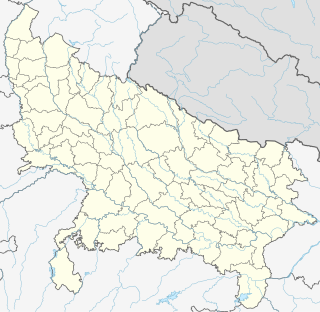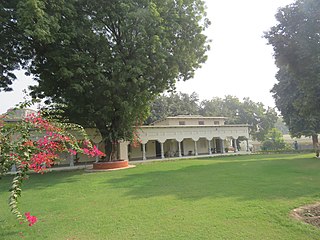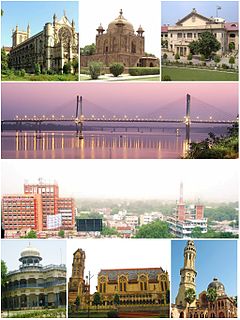Related Research Articles

Uttar Pradesh is a state in northern India. With over 200 million inhabitants, it is the most populous state in India as well as the most populous country subdivision in the world. It was created on 1 April 1937 as the United Provinces of Agra and Oudh during British rule, and was renamed Uttar Pradesh in 1950, giving it the acronym UP. The state is divided into 18 divisions and 75 districts, with the state capital being Lucknow, and Allahabad serving as the judicial capital. On 9 November 2000, a new state, Uttaranchal, was carved from the state's Himalayan hill region. The two major rivers of the state, the Ganges and Yamuna, join at Triveni Sangam in Allahabad and flow further east as Ganges. Other prominent rivers are Gomti and Saryu. The forest cover in the state is 6.1% of the state's geographical area. The cultivable area is 82% of total geographical area and net area sown is 68.5% of cultivable area.
The renaming of cities in India started in 1947 following the end of the British imperial period. Several changes were controversial, and not all proposed changes were implemented. Each had to be approved by the Central Government in New Delhi.

{{Infobox settlement | name = Bareilly | official_name = | native_name = | settlement_type = Metropolis

The Allahabad High Court, also known as High Court of Judicature at Allahabad is the high court based in Allahabad (Prayagraj) that has jurisdiction over the Indian state of Uttar Pradesh. It was established on 17 March 1866, making it one of the oldest high courts to be established in India.

Allahabad district, officially known as Prayagraj district, is the largest and the most populous district of Uttar Pradesh state of India. The district headquarters is Allahabad which was renamed Prayagraj at the same time as the district was renamed. The District is divided into blocks within tehsils. As of 2011, there are 20 blocks in eight tehsils. The Allahabad division includes the districts of Pratapgarh, Fatehpur, Kaushambi and Allahabad, with some western parts that had previously part of Allahabad District becoming part of the new Kaushambi District. The administrative divisions are Phulpur, Koraon, Meja, Sadar, Soraon, Handia, Bara, Shringverpur and Karchana.

Kaushambi district is a district in the state of Uttar Pradesh in India. Manjhanpur is the district headquarters. The district was carved from Prayagraj district on 4 April 1997. Manauri bajar connects Allahabad and Kaushambi districts by railway over a bridge on SH-95. Manjhanpur is south-west of Prayagraj on the north bank of the Yamuna river, about 55 kilometres (34 mi) from the city. It is surrounded by Chitrakoot district on the south, Pratapgarh district on the north, Allahabad district on the east and Fatehpur district on the west. Kaushambi is part of Prayagraj division. The nearest railway station, in Bharwari, connects with Delhi, Allahabad, Kolkata, Gaya and Kanpur.

Allahabad Airport, officially known as Prayagraj Airport, is a military airbase and public airport serving the city of Allahabad, in the state of Uttar Pradesh, India. It is located in Bamrauli, 12 km (7.5 mi) from Allahabad city and serves domestic flights. It is one of the oldest airports in India. The airport is jointly operated by the Indian Air Force and Airports Authority of India.

Shankargarh is a town and a nagar panchayat in Allahabad district in the Indian state of Uttar Pradesh.

Swaraj Bhavan is a large mansion located in Prayagraj, India, best known for once being owned by the Indian political leader Motilal Nehru and being home to the Nehru family until 1930.
Chatham Lines is a township of Allahabad, Uttar Pradesh, India, located near the historic Prayag railway station. It is located within the city of Allahabad, and is famous for Kumbh Mela, a major pilgrimage and festival site in Hinduism.
The Old Allahabad City, at the south of Prayagraj Junction Railway Station, consists of neighborhoods like Chowk, Johnstongunj, Dariyabad, Khuldabad etc. and was in existence from the time of Akbar. Some magnificent structures erected in this era consist of the Khusro Bagh and the Allahabad Fort. In the north of Railway Station, the New Allahabad City consists of neighborhoods like Lukergunj, Civil Lines, Georgetown, Tagoretown, Bharadwaj Puram, Ashok Nagar, Mumfordgunj etc., which are relatively new and were built during the British rule. These neighborhoods reflect British architecture like the All Saints Cathedral, Alfred Park and Allahabad High Court. Newer residential areas include neighborhoods like Kareli and suburbs like Naini and Jhunsi.

Prayagraj, formerly known as Allahabad, is one of the largest cities of the North Indian state of Uttar Pradesh in India. Although initially named Ilahabad the name later became Allahabad in an anglicized version in Roman script. In 2018 the name of the city was changed to Prayagraj by the State government ruled by Yogi Adhityanath. The city is situated on an inland peninsula, surrounded by the rivers Ganges and Yamuna on three sides, with only one side connected to the mainland Doab region, of which it is a part. This position is of importance in Hindu scriptures for it is situated at the confluence, known as Triveni Sangam, of the holy rivers. As per Rigveda the Sarasvati River was part of the three river confluence in ancient times. It is one of four sites of the Kumbh Mela, an important mass Hindu pilgrimage.

Allahabad, officially known as Prayagraj, also known as Ilahabad, is a metropolis in the Indian state of Uttar Pradesh. It is the administrative headquarters of the Allahabad district—the most populous district in the state and 13th most populous district in India—and the Allahabad division. The city is the judicial capital of Uttar Pradesh with the Allahabad High Court being the highest judicial body in the state. As of 2011, Allahabad is the seventh most populous city in the state, thirteenth in Northern India and thirty-sixth in India, with an estimated population of 1.53 million in the city. In 2011 it was ranked the world's 40th fastest-growing city. Allahabad, in 2016, was also ranked the third most liveable urban agglomeration in the state and sixteenth in the country. Hindi is the most widely spoken language in the city.
Maulvi Liaquat Ali (1817-1892) was a Muslim religious leader from Allahabad (Prayagraj), in the state of Uttar Pradesh in present-day India. He was one of the leaders in the revolt against the British in 1857, in what is now known as the First Indian war of Independence, or the uprising of 1857. This war was also known as the First War of Independence. As one of the most prominent leaders, Maulvi Liaqat Ali belonged to Village Mahgaon in Pargana Chail of District Prayagraj. He was a religious teacher, an upright pious Muslim, and a man of great courage and valour. His family traced their descent from the Zainabi Jafri branch of Hashmis which had their offshoots at Jaunpur and other places. He was a humble and simple man but when he took the reins of the freedom struggle, he became a dreadful enemy of the British.

Chandrashekhar Azad Park is a public park in Allahabad. Built in 1870 to mark Prince Alfred's visit to the city, with an area of 133 acres, it is the biggest park in Allahabad. It was renamed after freedom fighter Chandra Shekhar Azad, who sacrificed his life here, during the Indian independence struggle in 1931.
Civil Lines are the residential neighbourhoods developed during the British Raj for its senior civilian officers like Divisional commissioner and District magistrate. These townships were built all over the Indian subcontinent and were allotted to civil officers in the respective countries. This is distinct from Forts and Cantonments, which were expressedly military establishments.

Allahabad Junction, officially known as Prayagraj Junction, is a railway station on the Howrah–Delhi main line, Allahabad–Mau–Gorakhpur main line and Howrah–Allahabad–Mumbai line. It is the headquarters of the North Central Railway Zone. It is located in Allahabad district in the Indian state of Uttar Pradesh. It serves Allahabad and the surrounding areas.
This is a timeline of the history of the city of Prayagraj, Uttar Pradesh, India.
References
- ↑ "Death of a small town" . Retrieved 22 April 2014.
- 1 2 3 Mishra, Pankaj (12 October 2011). Temptations of the West: How to be Modern in India, Pakistan and Beyond. London: Pan Macmillan. pp. 35–36. ISBN 9780330434683 . Retrieved 23 January 2014.
- ↑ Chatterton, Eyre. "A History of the Church of England in India". anglicanhistory.org. Retrieved 11 September 2013.
- 1 2 Jonathan M. Bloom, Sheila Blai (2009). The Grove Encyclopedia of Islamic Art and Architecture, Volume 3. Oxford University Press. p. 57. ISBN 978-8125013839.
- 1 2 Henry George Keene (1875). A Hand-book for Visitors to Lucknow: With Preliminary Notes on Allahabad and Cawnpore. J. Jetley. pp. 14–15. ISBN 81-206-1527-1.
- ↑ "Unsung story of Civil Lines". The Times of India. 3 July 2014. Retrieved 25 April 2018.
- ↑ Nayar, Pramod K. (2009). Days of the Raj: Life and Leisure in British India. Penguin Books India. p. 50. ISBN 9780143102809 . Retrieved 23 January 2014.
- ↑ Dixit, Kapil (14 August 2014). "Cops conserve British era records". The Times of India . Allahabad. Retrieved 15 September 2014.